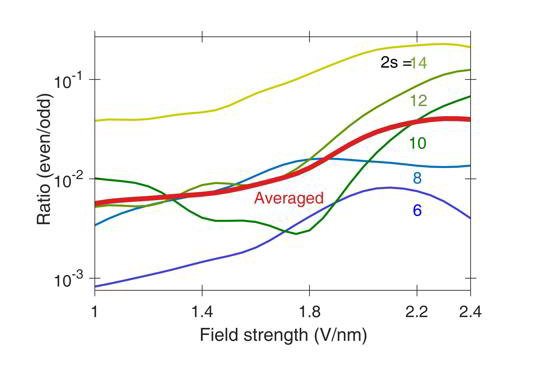Emerging from the strong-field driven solids, high-harmonic generation (HHG) has become a frontier of ultrafast electron dynamics and attosecond physics in condense matter. High-harmonic spectroscopy provides an opportunity to steer ultrafast electron dynamics in subcycle timescale and a promising route to produce coherent light pulses in extreme ultraviolet region with enhanced yield. Because of the complexity of solid materials, HHG shows a variety of new phenomena and corresponding mechanisms. Especially, even-order harmonics are generated by breaking the inversion symmetry of a system. In spite of the widely adopted theoretical models in length gauge, velocity gauge preserves the translational symmetry of the crystal structure and decouples electron dynamics of different crystal momentum, which can be advantageous in interpreting the even-order harmonics generation.
The research introduced by Dr. Jiayuan Cao from Shanghai Institute of Optics and Fine Mechanics, Chinese Academy of Sciences, studied the high-harmonic generation from inversion asymmetric solids under the frame work of velocity gauge, from which the mechanisms of even-order harmonics generation are revealed. The research results are published in Chinese Optics Letters, Volume 19, Issue 4, 2019 (J. Cao, et al., Even-order high-harmonic generation from solids in velocity gauge).

Dependence of the intensity ratio between even- and odd-order harmonics on the pump field strength.
To demonstrate the high-harmonic generation from the strong-field excitation, they started from an inversion-asymmetric one-dimensional periodic potential. Driven by strong laser fields, the multiple-electron dynamics is calculated using the semiconductor Bloch equation (SBE) in the velocity gauge. They reveal that the even-order harmonics originate from the multiple-step transitions among the energy bands in momentum space, while the odd-order harmonics are mainly from direct transitions. In addition, the lower valence band has proved indispensable in the generation of even-order harmonics, which differs from the inversion-symmetric. The intensities of even- and odd-order harmonics show different laser field strength scaling behavior. As the laser field amplitude increases one-fold, the relative intensity ratio between the even- and the odd-order harmonics increases one order of magnitude. This can be ascribed to the rapid increasing of hole population in the lower valence band that enhanced the multiple-electron interference, under the stronger laser irradiation.
This work offers an alternative perspective to look inside the interaction between the intense laser field and inversion-asymmetric solids. The researchers believe that the proposed mechanism is widely applicable to real solid systems with broken inversion symmetry, such as bulk crystals and two-dimensional materials, which will provide a new understanding of the highly nonequilibrium dynamics of electrons in solids driven by intense laser fields.


